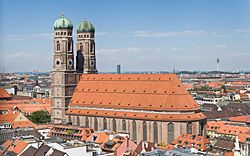Munich Frauenkirche
| Dom zu Unserer Lieben Frau Frauenkirche | |

Frauenkirche viewed from nearby Peterskirche's Tower |
|
| Basic information | |
|---|---|
| Location | Munich, Bavaria, Germany |
| Geographic coordinates | 48° 8′ 19″ N, 11° 34′ 26″ E |
| Religious affiliation | Roman Catholic |
| District | Roman Catholic Archdiocese of Munich and Freising |
| Ecclesiastical status | Cathedral |
| Architectural description | |
| Architect(s) | Jörg von Halsbach |
| Architectural style | Gothic architecture and the domes constructed in Renaissance style |
| Year completed | Consecrated in 1494, Domes added in 1524 |
| Specifications | |
| Capacity | 20,000 |
| Length | 109 meters (358 ft) |
| Width | 40 meters (131 ft) |
| Spire(s) | 2 |
| Spire height | 99 meters (325 ft) |
| Materials | Brick |

The Frauenkirche (full name Dom zu unserer lieben Frau, "Cathedral of Our Blessed Lady") is the largest church in the Bavarian capital of Munich. Located in the city center at Frauenplatz 1, the Catholic cathedral is a major landmark and a popular tourist attraction.
Today, the cathedral and the New Town Hall dominate the city center, and its towers can be seen from all directions. It will remain so since the city of Munich passed a provision prohibiting the building of any structure over 100 meters (328 ft). The south tower can be ascended and offers a panoramic view of the city and the Alps.
Contents |
History
The cathedral which replaced an older church built in the 12th century, was commissioned by Duke Sigismund and erected by Jörg von Halsbach. Construction began in 1468 and the two towers were completed in 1488. The church was consecrated in 1494. However, the building's famous domes atop each tower were not built until 1525. Their design was modelled on the Dome of the Rock in Jerusalem, which in turn took a lead from late Byzantine architecture. The cathedral suffered severe damage during World War II — the roof collapsed and one of the towers suffered severe damage. A major restoration was started after the war and was completed in several stages, the last in 1994.
Architecture
The Frauenkirche was constructed from red brick in the late Gothic style within only 20 years. The building is designed very demure without rich gothic ornaments. The structure is 109 meters or 358 feet long and 40 meters (131 ft) wide. The two towers are 99 meters (325 ft) high, with one tower taller than the other by 12 cm (4.75 inches). The original design called for pointed spires to top the towers, much like Cologne Cathedral, but those were never built due to lack of money. Instead, the two domes were built during the Renaissance, and are mismatched stylistically with the rest of the building. But this way they have become a distinctive landmark of Munich.
Interior


The cathedral can hold around 20,000 people, and Catholic services are held regularly. The interior of the cathedral, which is among the largest hall churches in southern Germany, consists of three naves of equal height (31m).
A rich collection of 14th to 18th century artwork of notable artists like Erasmus Grasser, Jan Polack, Hans Krumpper and Ignaz Günther decorates the inside the cathedral again since the last restoration. Several of the Gothic stained-glass windows, some of them were made already for the previous church, and the tomb monument of Louis IV, Holy Roman Emperor belong to the major attractions.
Much of the interior was destroyed during WWII, and even the restored parts look still plain by comparison. However, two of the attractions still can be found are the Gothic nave and the Teufelstritt, or Devil's Footstep, at the entrance. This is a black mark resembling a footprint with a small hooked tail at the heel, which, according to legend, was where the devil stood when he curiously regarded and ridiculed the windowless church that Halsbach had built. In fact, it is a large casting in the square base plate, and none of the side windows can be seen from the spot when one looks to the high altar. In another Version of the Legend the devil made a deal with the builder that no windows were to be built in the church. But the devil was tricked by the clever builder who had set the columns so that you couldn't see a single window from a certain spot in the entrance hall where the devil stood. When the devil found out he was tricked the church was already consecrated so he couldn't enter but left a footprint at the entrance where he madly stomped his foot.
The crypt contains the tombs of the Archbishops of Munich and Freising and among others of these members of the Wittelsbach dynasty:

- Louis IV, Holy Roman Emperor
- Duke Louis V
- Duke Stephen II
- Duke John II
- Duke Ernest
- Duke William III
- Duke John IV
- Duke Albert IV
- Duke William IV
- Duke Albert V
- King Ludwig III
See also
- Munich
- Dresden Frauenkirche
- Petrosomatoglyph